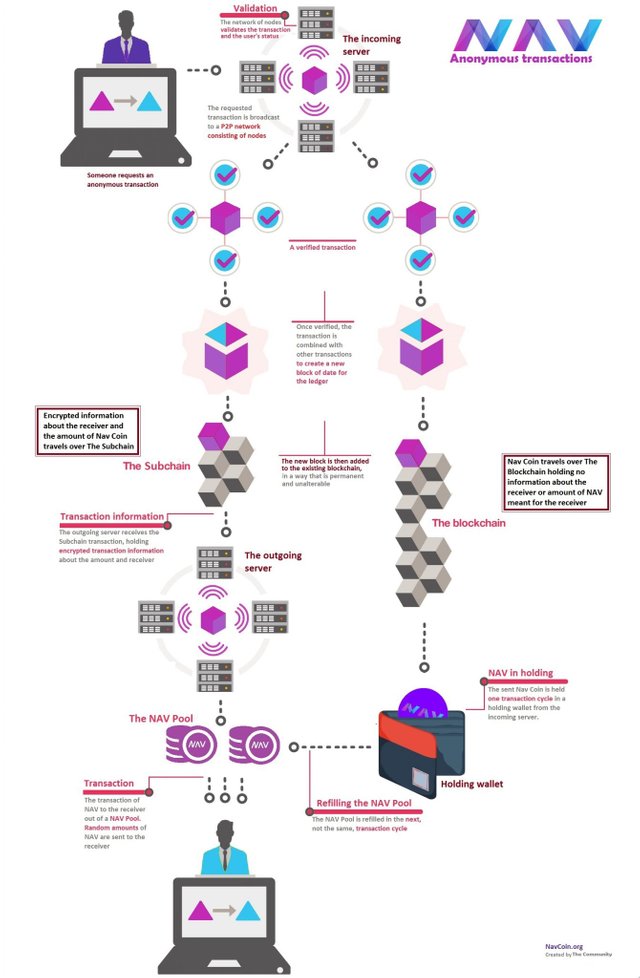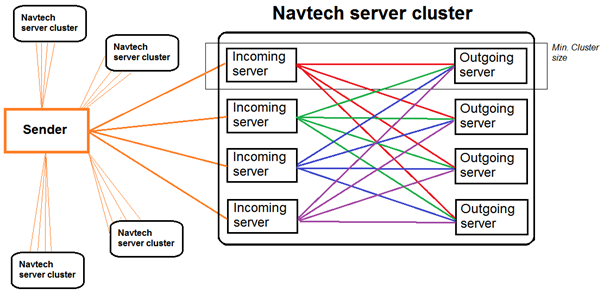NAV COIN: Anonymous transactions explained (info)
Nav Coin has a 30 second block time. This means that a Nav Coin block on the Nav Coin Blockchain is mined every 30 seconds. A Blockchain works fairly simple. Transactions are made and the transaction data is put into a block. A block is just a collection of transactions and data. Miners verify a block and after the block gets added to the chain.
Normal Nav Coin transactions are very similar to Bitcoin transactions. This means the transactions are recorded on the Nav Coin Blockchain and verified by miners. Those transactions have a very low fee and fast transaction time. Within 30 seconds the transactions are confirmed but generally the coins will show up faster in the Receiver’s wallet.
Nav Coin users have the option to make anonymous transactions. The connection between the Sender and Receiver is broken by using a secondary Blockchain, the Subchain. By using a secondary Blockchain Nav stays transparent and has all the benefits of Blockchain technology. Nav Coin is decentralized, meaning there is no central point of operations controlling everything and being a weak point to take Nav offline.
The Nav Coin anonymous transaction system is called “Navtech”. Navtech makes use of two Blockchains to disconnect Sender and Receiver. The connection between the Sender and Receiver is broken by using the secondary Blockchain, the Subchain. It is a little more complicated than that but with a short explanation, together with the Infographic below, it should be possible to understand the basics. First it goes to know that anonymous transactions are handled by Navtech Server cluster consisting of incoming and outgoing servers. Those server clusters can be setup by everyone and the software is open source.
Only the Navtech clusters selected by the Sender are used for anonymous transactions. A Sender can also decide to not make use of any third party server cluster and setup an own server cluster. This will make anonymous transactions cheaper, because no transaction fees for using the Navtech server cluster have to be paid. Another benefit is being in total control of the server cluster and not depending on any other server operator.
So, the anonymous transaction… Note that everything is automated after the Sender confirms to send an anonymous transaction. Everything beyond this point is done automated and outside of view from the Sender and Receiver.
The Sender requests an anonymous transaction. An incoming server from the added Navtech server clusters is randomlyselected and contacted. The incoming server will verify if the transaction can be processed (transaction size, maximum number of transactions that can be handled by the server cluster, etc.). The incoming server selects a random outgoing server in the Navtech server cluster. See the image below. First randomly a pre-selected Navtech server cluster is selected. After that a random incoming server from the server cluster is selected and finally an outgoing server is randomly selected.
The Nav Coin is send from the Sender to the incoming server. The incoming server puts the Nav Coin in a temporarily holding wallet. The incoming server collects the data of the transaction, Receiver’s address and the number of Nav Coin meant for the Receiver. So now the data and Nav Coin have been separated by the incoming server. The incoming and outgoing server communicate over the secondary Blockchain, the Subchain. To send the data from the incoming server to the outgoing server, the data is connected to SUB. SUB is a coin that travels over the Subchain. The incoming server sends the data and SUB over the Subchain to the outgoing server. The outgoing server now knows who to pay and how much to pay.
The outgoing server is loaded with Nav Coin in a pool, the Navpool. The outgoing server pays Receivers out of the Navpool. So, with the data and Nav Coin the outgoing server is able to make the payment. The Nav Coin is send to the Receiver. The payment is not done in one time. Imagine the Sender sending 100 Nav Coin and the Receiver receiving 100 Nav Coin 2 minutes later, this will make the system vulnerable to meta-analysis. For this reason the Nav Coin is send to the Receiver in a random amount of transactions of arbitrary size.
Now the Nav Coin from the Sender is still in the holding wallet of the incoming server. The Navpool of the outgoing server is in the minus because of sending the Nav Coin to the Receiver out of the Navpool.
The transactions happen in cycles of 2 minutes. Every 2 minutes a Navtech Server Cluster accepts transactions and processes them. The Nav Coin from the holding wallet has to go to the Navpool to refill it. This happens in the following transaction cycles. So the Nav Coin send by the Sender is moved from the holding wallet to the Navpool.


I really like that Graphic Colvano... great work
If anyone is interested @Btcpopco has pooled staking for NAV (if you’re not tech savvy like me)